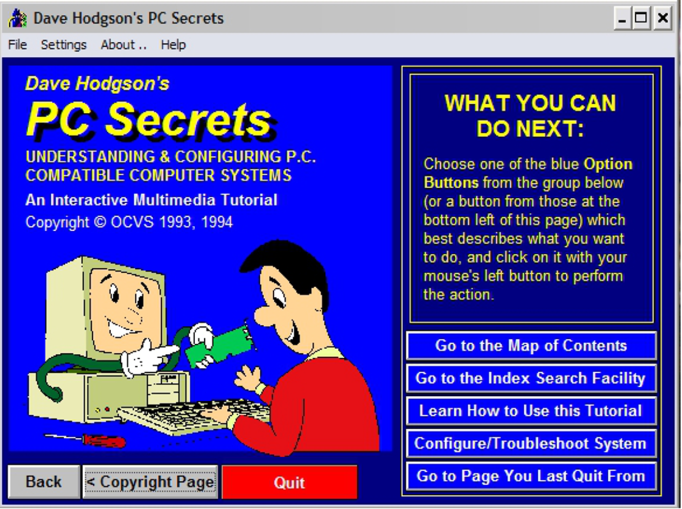
OCVS Booth, Windows Solutions Conference 1993
The 1993 photo above shows me effectively embarking on a new career, and not quite sure what I’d started! I was at my business’s own booth, during the first trade show where I was promoting my own product.
Of course, I’d attended, and even worked at, many trade shows prior to that, but I’d always been there as a representative of someone else’s company or organization.
Short-Sighted Employers
The series of events that led to my first attempt to develop and sell my own software provided a thought-provoking lesson in the tragic short-sightedness of many employers and businesses. Until then, I had implicitly but naively assumed that, as technology changed, my employers would “keep their eyes on the ball” and change their products (and my role in the organization) accordingly.
Far from it, in reality! Most employers seemed to think of their employees as fitting into neat, predefined boxes, and their view was that the box (and the employee within it) should stay the same for ever more. Their attitude seemed to be that, if they had once hired an oil-lamp lighter, then that person should continue to light the oil lamps for ever more, even if oil lamps had in the meantime become obsolete!
As a result of my education and industry experience, I felt that I could discern something about the way computer technology would evolve in the future, and it seemed obvious that I should attempt to evolve in the same direction. Unfortunately, as explained below, not only were my attempts to redefine my role not supported by my employer, but they even actively resisted my attempts to change!
Going with the Flow (or Trying to)
As I’ve mentioned in previous posts, my goal in obtaining an electronics degree had been to get a job working “in video”. I’d come to consider that as a desirable career as a result of one day’s teenage experience, when my friend Graham Roberts took me along with him to his shift as a Continuity Announcer for Yorkshire Television.
I really hadn’t considered electronics for any other reason. Unlike some other boys, I was not an electronics hobbyist, and I didn’t even have a “microcomputer” to tinker with.
When I started my video engineering career, the reality was that real-time digital video processing required special hardware. General-purpose computers simply weren’t even fast enough to stream video in real time, let alone modify the pixels.
However, as processing speeds increased, computers became able to handle digital video in real time. As a result, it became possible to write software to process video in ways that would previously have required specialized hardware.
I wanted to move over to some type of software development, but my employer at the time (Media Vision) seemed to be trying to restrict me to hardware development only. My manager apparently decided (without consulting me) that I should become an integrated circuit design engineer, and bought development equipment for me to do that!
Frustrated by their short-sightedness, I quit my job and started my own business, initially with the intention of producing video in some form.
(As things turned out, Media Vision collapsed quite spectacularly some time after I left, so my decision to quit seemed very smart in retrospect!)
No Video Available
Oddly enough, despite my prior programming experience, when I started my own business I did not set out to develop a software product! My initial project was to develop an instructional video, which would be distributed on standard VHS tapes.
I’d created a “treatment” for my video, but I did not myself possess video cameras and editing equipment. It seemed fortunate that a friend of mine had simultaneously started his own video editing business, so we agreed to co-operate on the production. Unfortunately, as the months went by, it seemed that he was never quite ready to begin shooting, and I reluctantly realized that I was going to have to find another way to deliver my product.
My job at Media Vision had had me designing PC hardware for the new “multimedia” technology (which basically involved adding audio and video capabilities to PCs). It struck me, therefore, that perhaps I could create some kind of “multimedia computer tutorial” as a substitute for the planned video.
I had learned to program while at college, and as I related in a previous post, even before that, I had undergone an aptitude test that indicated that I would make a good programmer. Nonetheless, the only complete programs I’d written at that point were small utilities for my own use, or that of my colleagues, when processing data as part of our hardware design jobs. I had also written “embedded” software for custom hardware, but I had never tried to create what is called a “shrink-wrap” software application. Shrink-wrap software is a standalone product that can be sold to consumers, who then install it on their own computers and expect it to run with little or no further involvement from me.
Creating a shrink-wrap software application seemed like a significant challenge, and I wasn’t sure that I could actually do it. Nonetheless, there seemed to be little alternative, so I sat down to learn a multimedia software creation tool called Asymetrix Toolbook.
My First App
The eventual result was “Dave Hodgson’s PC Secrets”, which was a software application for Windows computers (what would now be called an “app”). The initial screen looked like this:

PC Secrets Software Title
Unfortunately, sales of the product were not great, which led me to seek consulting work. Although I did accept a couple of hardware design consulting projects, it was obvious that much more work was available for software consultants.
Fortunately, I discovered that the fact that I’d just created my first software “app” qualified me for consideration as a Windows software consultant! That led to many years of work for me as a consulting software developer.
Do Anything You Want to Do, But Don’t Expect Our Support!
That was how I learned that I couldn’t rely on my employer to have my best interests at heart, nor even to be concerned about my career development. It had been clear to me that the future of video (for me, at least) lay in software, but my employer would not support my ambitions.
While I think that most self-help advice along the lines of “do what you want” is simply naïve, I did find that, in order to achieve my goals, I had to define those goals myself, then actually invest considerable time and effort of my own to achieve the results I desired.



